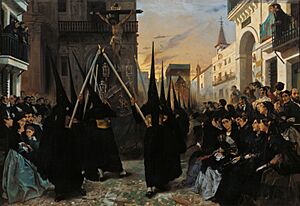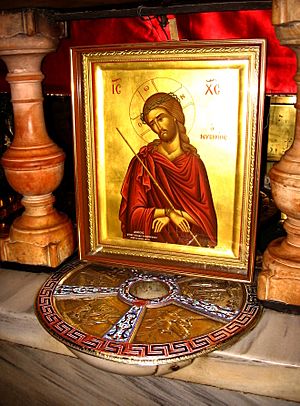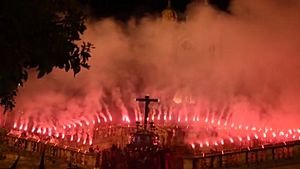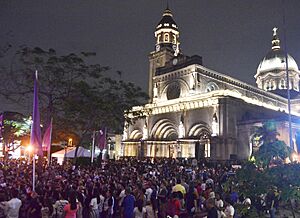Holy Week facts for kids
Quick facts for kids Holy Week |
|
|---|---|
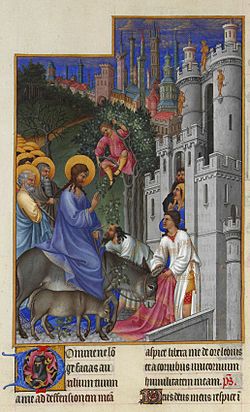
The entry of Jesus and his disciples into Jerusalem on Palm Sunday marks the beginning of Holy Week, is the last week of Lent, between Palm Sunday and the dusk of Maundy Thursday. In the Eastern Orthodox Church, Palm Sunday along with the Saturday of Lazarus marks the two-day transition between the 40 days of Great Lent and Holy Week.
|
|
| Type | Christian |
| Observances | Palm Sunday, Holy Monday, Holy Tuesday, Holy Wednesday, Maundy Thursday, Good Friday, Holy Saturday and Easter Sunday |
| Date | Last week of Lent |
| 2024 date |
|
| 2025 date |
|
| 2026 date |
|
| 2027 date |
|
| Frequency | Annual |
| Related to | Eastertide |
Holy Week is the most important week in the Christian year. It is the week leading up to Easter and remembers the final days of Jesus's life. The week begins on Palm Sunday, which celebrates Jesus's arrival in Jerusalem.
During Holy Week, Christians remember the betrayal of Jesus on Holy Wednesday and the Last Supper on Maundy Thursday. The week reaches its most serious point on Good Friday, which marks the day of Jesus's crucifixion and death. Holy Week ends with Holy Saturday, the day Jesus's body lay in the tomb.
After Holy Week, the season of Eastertide begins with Easter Sunday, the celebration of Jesus's resurrection. Holy Week services often have the largest church crowds of the year. Many cultures have special traditions, like processions, plays, and special church services.
Contents
History of Holy Week
Holy Week is the week right before Easter. The tradition of treating this week as special is very old. It dates back to the 3rd and 4th centuries. Early Christian writings, like the Apostolical Constitutions, mention special rules for this week, such as fasting.
One of the first days to become important was Good Friday. The next was Holy Saturday, also called the "Great Sabbath." Early Christians held a special nighttime service called a vigil, waiting for Easter.
A famous travel diary by a woman named Egeria from the 4th century describes in detail how Holy Week was celebrated in Jerusalem at that time. Today, many Christian churches, including Catholic, Lutheran, Anglican, and Methodist churches, have very similar services for Holy Week.
Holy Week in Western Christianity
In Western churches, like the Catholic and Protestant churches, Holy Week is the last week of Lent. It starts on Palm Sunday and ends on Holy Saturday.
Palm Sunday
Holy Week begins with Palm Sunday. This day remembers Jesus's triumphal entry into Jerusalem, an event described in all four Gospels. When Jesus rode into the city on a donkey, crowds welcomed him by shouting praises and waving palm branches.
To remember this, many churches give out palm leaves to the people attending the service. These leaves are often blessed by a priest. Christians take the palms home and hang them near crosses or keep them in their Bibles. The church service on this day also includes a reading of the Passion, which is the story of Jesus's suffering and death.
Holy Monday, Tuesday, and Wednesday
The days between Palm Sunday and Maundy Thursday are Holy Monday, Holy Tuesday, and Holy Wednesday. On these days, Christians remember the last events of Jesus's life before his arrest.
- Holy Monday: Churches may remember Jesus cleansing the Temple or the anointing of Jesus at Bethany.
- Holy Tuesday: This day focuses on Jesus's teachings and his predictions of his own death.
- Holy Wednesday: This day is sometimes called "Spy Wednesday." It is the day Christians remember that Judas Iscariot made a deal with the chief priests to betray Jesus.
A special service called Tenebrae (which means "darkness" in Latin) is sometimes held during Holy Week. During this service, candles are slowly put out one by one while psalms and readings are chanted.
Maundy Thursday
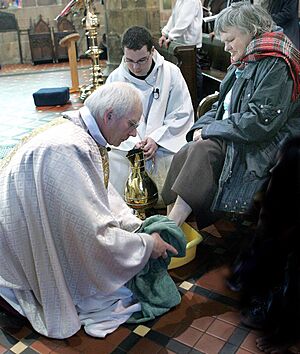
Maundy Thursday, also called Holy Thursday, remembers the Last Supper. This was the final meal Jesus shared with his apostles before his death. During this meal, he introduced the practice of the Eucharist, or Holy Communion.
A special tradition on this day is the washing of feet. The priest may wash the feet of twelve people, just as Jesus washed the feet of his twelve apostles. This act is a symbol of humility and service.
After the evening Mass, the church bells fall silent until the Easter Vigil. The altar is stripped of its cloths, and crosses may be covered or removed. This creates a simple and somber atmosphere in the church.
Good Friday
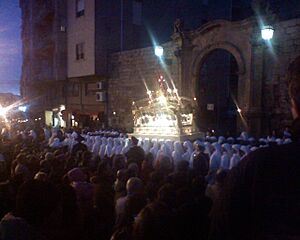
Good Friday is the day Christians remember the crucifixion of Jesus and his death. It is a very solemn and mournful day. Many Christians fast on Good Friday, eating only one simple meal.
Church services on this day are not a regular Mass. Instead, there is a special service called the Celebration of the Lord's Passion. It includes readings from the Bible, prayers for the world, and the Veneration of the Cross, where people show respect to a crucifix.
In many countries, like Spain, Italy, and the Philippines, there are large public processions. People carry statues that show scenes from Jesus's Passion. Another popular tradition is the Stations of the Cross, a prayerful walk that follows the 14 steps of Jesus's journey to his crucifixion.
Holy Saturday
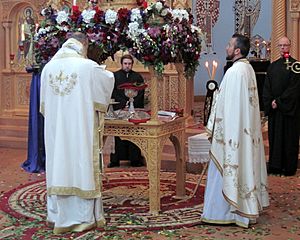
Holy Saturday is the day between Jesus's death on Friday and his resurrection on Sunday. It is a quiet day of waiting and prayer. The Gospels say that Jesus's body was placed in a tomb on this day. No Mass is celebrated in the Catholic Church on Holy Saturday.
The most important service of the year, the Easter Vigil, begins after sunset on Saturday night. This service celebrates the resurrection of Jesus.
The Easter Vigil has four main parts:
- The Service of Light: A new fire is lit outside the dark church. The large Paschal candle, representing the light of Christ, is lit from this fire.
- The Liturgy of the Word: There are several readings from the Old and New Testaments that tell the story of salvation.
- The Liturgy of Baptism: New members are welcomed into the Church through baptism. The whole congregation renews their own baptismal promises.
- The Liturgy of the Eucharist: The first Mass of Easter is celebrated, and the newly baptized receive Holy Communion for the first time.
Easter Day
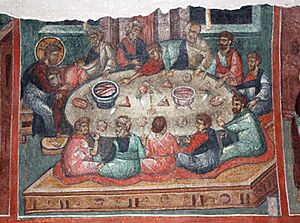
Easter Day, or Easter Sunday, is the greatest feast in the Christian calendar. It celebrates the Resurrection of Jesus Christ from the dead. This day marks the beginning of the 50-day Easter season, which lasts until Pentecost.
The resurrection is the main reason why Christians celebrate every Sunday as their primary day of worship.
Holy Week in Eastern Christianity
In the Eastern Orthodox Church, Holy Week is called "Great and Holy Week." The 40 days of Great Lent end the Friday before Palm Sunday. The next two days, Lazarus Saturday and Palm Sunday, are a bridge to Holy Week.
Fasting during Holy Week is very strict. Many Orthodox Christians avoid meat, dairy, oil, and alcohol.
Great and Holy Monday, Tuesday, and Wednesday
The services on these days are often called "Bridegroom Prayers." They focus on the theme of Jesus as the Bridegroom of the Church. An icon showing Jesus wearing a crown of thorns is placed in the center of the church.
On Tuesday evening, a famous hymn called the Hymn of Kassiani is sung. It tells the story of the sinful woman who washed Jesus's feet with her tears and dried them with her hair.
Great and Holy Thursday
On this day, the Divine Liturgy of the Last Supper is celebrated. In cathedrals and monasteries, the bishop or abbot may perform the Washing of Feet ceremony. This is the only day during Holy Week when those following the strictest fast will eat a cooked meal.
Great and Holy Friday
On Thursday night, a special service is held with twelve Gospel readings that tell the story of Jesus's crucifixion. A large cross is placed in the center of the church for people to venerate.
On Friday, a cloth icon called the Epitaphios, which shows the body of Christ prepared for burial, is carried in a procession and placed in a "tomb" decorated with flowers.
Great and Holy Saturday
On Friday evening, a service of "Lamentations at the Tomb" is held. The clergy and the people gather around the tomb and sing hymns. Later, the Epitaphios is carried in a procession around the outside of the church.
The Paschal Vigil begins late on Saturday night. At midnight, the priest lights a candle from the altar, and the light is passed to everyone in the dark church. A procession goes around the church, and then everyone enters joyfully, singing hymns of the resurrection.
Holy Week Celebrations Around the World
Many cities are famous for their large and beautiful Holy Week processions.
| Country | City |
|---|---|
| Colombia | Popayán, Tunja |
| Guatemala | Antigua Guatemala, Guatemala City |
| Honduras | Comayagua, Tegucigalpa |
| Mexico | Iztapalapa |
| Philippines | Baguio, Cebu City, Manila, San Fernando, Pampanga |
| Spain | Seville, Valladolid, Málaga, León |
| Italy | Trapani, Ruvo di Puglia |
Spain
In Spain, cities like Seville and Málaga are famous for their processions. They feature large, lifelike wooden sculptures called pasos or tronos. These sculptures show scenes from the Passion of Christ.
The sculptures are carried through the streets by members of religious brotherhoods called cofradías. Some members, called Nazarenos, wear long robes and pointed hoods that cover their faces. This is a sign of penance, or sorrow for sins. Marching bands often play solemn music during the processions.
Philippines
In the Philippines, Maundy Thursday and Good Friday are national holidays. Many people travel to their hometowns for the week. Street processions feature wheeled floats called carrozas that carry statues of saints.
A popular tradition is the Visita Iglesia (Church Visit), where people visit seven different churches on Maundy Thursday to pray. Another tradition is the Pabasa, a non-stop chanting of a poem about the life and death of Jesus, which can last for days.
On Easter Sunday morning, a special ceremony called the Salubong takes place. Statues of the risen Jesus and his mother Mary are carried in separate processions and then meet, celebrating their reunion.
Images for kids
-
A Washing of Feet ceremony on Holy Thursday in the Armenian Orthodox church
-
A Good Friday procession in Ecuador. The man is shown holding a cross, representing the one upon which Jesus was crucified.
-
The General Good Friday Procession in Valladolid, Spain in front of the City Hall.
-
Holy Saturday in Caulonia, Italy
-
A church in Florianópolis, Brazil, prepared for the Good Friday celebrations.
-
Jesús de los Milagros procession, San José Church, Palm Sunday in Guatemala City
-
Holy Week in Comayagua, Honduras.
-
The "Misteri", the Holy Week procession in Trapani
-
Holy Week in Barcellona Pozzo di Gotto, Italy
-
Holy Week in Ruvo di Puglia, Italy
-
Holy week in Lorca, Spain
-
Resurrection of Jesus in the Saints Peter and Paul church, Bilky, Khust Raion, Ukraine
-
The Epitaphios (Plashchanitza) placed in the nave of the church for the faithful to venerate. The Gospel Book rests in the center.
-
People receiving the Holy Light at Easter from Father Diogenis at St George Greek Orthodox Church, Adelaide
-
The Church of Saint Mary in Haret Elroum on Good Friday
-
The Virgin of Hope of Macarena in Seville, Spain, shown in her sorrowful theme.
-
Russian Orthodox icon of the Resurrection of Jesus Christ depicting his descent into Hades, 16th century.
See also
 In Spanish: Semana Santa para niños
In Spanish: Semana Santa para niños


